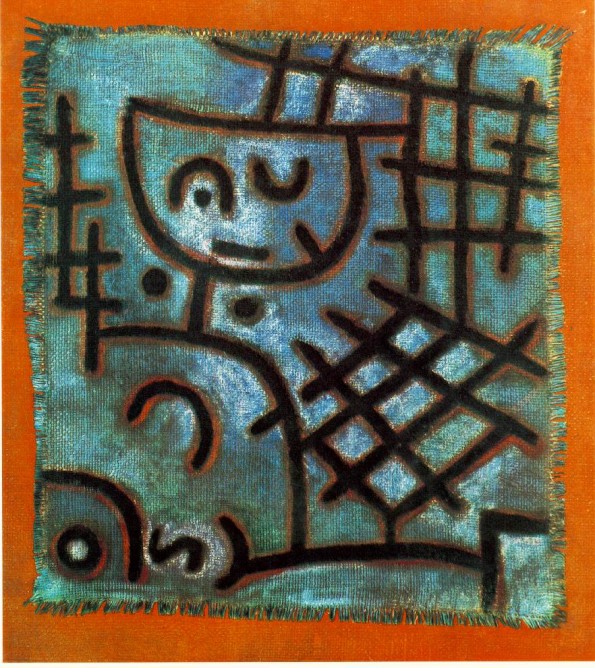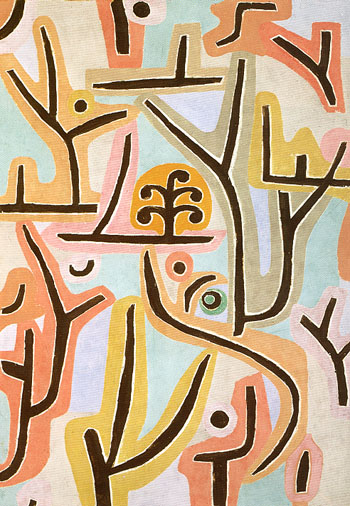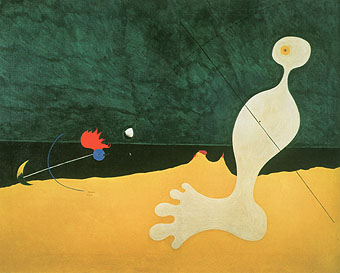Skip to comments.
After 66 years, Paul Klee's paintings finally find a permanent home
Santa Fe New Mexican, ^
| June 21, 2005
| UTA HARNISCHFEGER
Posted on 06/22/2005 12:13:34 AM PDT by nickcarraway
click here to read article
Navigation: use the links below to view more comments.
first 1-20, 21-28 next last
To: nickcarraway
I thought he had a permanent exhibit in Munich. They have a great collection that I saw in the late seventies.
2
posted on
06/22/2005 12:27:24 AM PDT
by
lainde
To: nickcarraway

Klee Arab Song

Klee Captive

Klee Park near Lucerne
Thanks for the post. Klee loved a child-like quality in art, uncorrupted and free. His work can be characterized under Surrealism with its dream-like inspiration. I expect that there will be many comments that his work could be done by a child, and he wanted that quality to his work. However, there is a deceptive variety and sophistication to his style. For instance, in the Arab Song at the top, one can see references to Arab women as well as a window or even a cat.

Piano's plan for the Klee Museum.

Rogers and Piano's Pompidou or Beaubourg Museum in Paris. This is where all the modern art in Paris is located.
To: Sam Cree; Liz; Joe 6-pack; woofie; vannrox; giotto; iceskater; Conspiracy Guy; B Knotts; Dolphy; ...
Art ping.
Let Sam Cree or I know if you want on or off this list.
To: Republicanprofessor
Art Appreciation/Education ping. Let me know if you want on or off this list.
Our next "class" will be about Surrealism. Klee is not part of the Magic Surrealism (which included Dali and his "melting clocks"). Instead, he belongs to Biormophic Surrealism, which includes the work of Miro, and which deals with organic images coming from deep inside and which often don't bear much resemblance to external reality.


Dali Persistence of Memory and Miro Person Throwing a Stone at a Bird
To: Sam Cree; Liz; Joe 6-pack; woofie; vannrox; giotto; iceskater; Conspiracy Guy; B Knotts; Dolphy; ...
Now this is the real Art Appreciation/Education ping.
Let me know if you want on or off the list.
To: nickcarraway
Klee is one of my all time favorite artists.
7
posted on
06/22/2005 10:39:45 AM PDT
by
finnman69
(cum puella incedit minore medio corpore sub quo manifestus globus, inflammare animos)
To: nickcarraway
8
posted on
06/22/2005 10:40:25 AM PDT
by
Aquinasfan
(Isaiah 22:22, Rev 3:7, Mat 16:19)
To: Republicanprofessor
Don't forget some of Dali's post 1940 "classic" works.
To: Republicanprofessor
What gorgeous colors and vibrancy.
I wish I could paint like that.
To: aristotleman
This is just a small selection of his work. Hard to choose which to post.
To: Aquinasfan
These are paintings?Often Klee used watercolor on burlap, so that he got a rough but transparent effect.
To: finnman69
Klee is one of my all time favorite artists. I guess then it's time to visit Switzerland. You can let us know how the museum is, architecturally and aesthetically. Bring back some pictures we can post.
To: Republicanprofessor
Did he prime the burlap in any way, and how are the
colors preserved so well?
To: Republicanprofessor
How about a bit more on Biormophic Surrealism, before we move on to Surrealism?
15
posted on
06/22/2005 12:21:18 PM PDT
by
nuconvert
(No More Axis of Evil by Christmas ! TLR) [there's a lot of bad people in the pistachio business])
To: Republicanprofessor
Can we spend a bit more time on Miro? This work and some others reminds me of Kandinsky
Chiffres et Constellations

16
posted on
06/22/2005 12:29:08 PM PDT
by
nuconvert
(No More Axis of Evil by Christmas ! TLR) [there's a lot of bad people in the pistachio business])
To: nuconvert
Wow, are there a lot of hidden images in the Miro you posted. I'm still counting 'em. Don't know what they all are, though.
A couple of fish, a cat, a clown, hmmmm. What else?
Now, that's a happy piece of art one could put on the wall of one's rec room.
Leni
17
posted on
06/22/2005 3:01:14 PM PDT
by
MinuteGal
(Remember, Half the People You Know are Below Average)
To: finnman69
18
posted on
06/22/2005 3:48:11 PM PDT
by
stands2reason
(It's 2005, and two wrongs still don't make a right.)
To: nuconvert
Yeah, we should explore the Bauhaus modernists some more...
19
posted on
06/22/2005 3:49:51 PM PDT
by
stands2reason
(It's 2005, and two wrongs still don't make a right.)
To: MinuteGal; nuconvert
More time on Miro and Bauhaus; okay, here goes.
Miro actually began as a cubist, but then he evolved into a surrealist. He was Spanish, from Catalonia, as was Dali and Gaudi. I think there must have been some funny stuff in the water up there, because these could be seen as three of the strangest artists/architects in history. First, a cathedral by the architect Gaudi, who was working at the end of the 19th and beginning of the 20th century.

Gaudi Sacrada Familia Barcelona, Spain; one needs to see even more works by Gaudi to get a real image of his variety and imagination.
So Juan Miro (1893-1983) began working in the teens or so, and his early works are in a cubist vein. Then his Farm and Tilled Field become more abstract until we no longer recognize the cow, or dog, or barn or other images. The way that he combines the ladder and the eye, and other circus like imagery in Harlequin’s Carnival is what makes him Surreal, in the use of dream-like imagery. But because his imagery is more organic, rounded, imaginative and not as based in reality as Dali, he is seen as a Biormorphic Surrealist.

Miro The Village

Miro The Farm c. 1925 A footnote of interest is the Ernest Hemingway bought this painting soon after it was finished, I think for about $100. Do you see any aspects of Spain in here that we see also in his novels?

Miro The Tilled Field late 1920s

Miro Harlequin’s Carnival
I had an accountant who had prints of Miro’s work all over her office. I was surprised and asked what intrigued her. She responded that she appreciated the happy attitude, despite living through the horrors of two world wars and some personal tragedies, he was still upbeat in his work, as Leni also noted above. What is also fun is that I don’t see all the things that Leni sees in that other posted work by Miro, but that doesn’t matter. It is joyful and imaginative, and that’s what’s important. Each of us can see different things, and that’s fine.
BTW, Biomorphic Surrealism is just one branch of Surrealism. Some of these lines get a bit blurred when we get to the Bauhaus, where there may be more similarities in abstraction between Klee and Kandinsky than differences. Kandinsky's work at the Bauhaus became more theoretical and, some might say, a bit stiffer. The lines are much more hard-edged, and some miss the spontaneity of his earlier brushwork. But there is still life in these tighter works.
Here are some of his later Bauhaus works. Do you like them better or worse than his earlier ones, such as Composition IV, that were posted earlier (in http://www.freerepublic.com/focus/f-chat/1424087/posts)

Kandinsky Composition IV c. 1913

Kandinsky Composition 8 1920s-30s
Kandinsky was one of the first, if not the first, to actually write about abstraction in a rational, theoretical way. In Point and Line to Plane and Concerning the Spiritual in Art, he wrote about what effect certain colors and shapes had. He felt that yellow was like a triangle in harshness; but I feel that yellow creates a circle. (I am probably more trite in my perception, like a sun in early children’s works.) It doesn’t matter so much if we agree with him; what matters is that he was the first to think about abstraction like that.
The Bauhaus was probably the most influential school of design between the wars. It was set up in Weimar initially in 1919 by Walter Gropius and then moved to Dessau about 1923 with a new campus designed by Gropius. Great artists from all over Germany worked there: Josef Albers, Klee, and Kandinsky were just a few of them. They aimed to rebuild Germany with great architecture and design for all, including the lower and middle classes. It was closed by Hitler in 1933. Below: Gropius’ Dessau campus with the International style of architecture: sleek planes, metal and glass, with open studio spaces inside. This style of architecture echoed the flat planes of cubism, but in three dimensions.

Navigation: use the links below to view more comments.
first 1-20, 21-28 next last
Disclaimer:
Opinions posted on Free Republic are those of the individual
posters and do not necessarily represent the opinion of Free Republic or its
management. All materials posted herein are protected by copyright law and the
exemption for fair use of copyrighted works.
FreeRepublic.com is powered by software copyright 2000-2008 John Robinson















